
Home Book Art Quilts Quilt Repair Lectures and Workshops Quilt History Costumes Resumé Contact
Quilt Repair
Learning to Repair About Me What is Quilt Repair? Deciding How to Treat Your Quilt Washing Antique Quilts
How to Contact Me for Quilt Repair

Learning to Repair
Workshop, Virtual - Description at Preserving Our Quilt Legacy
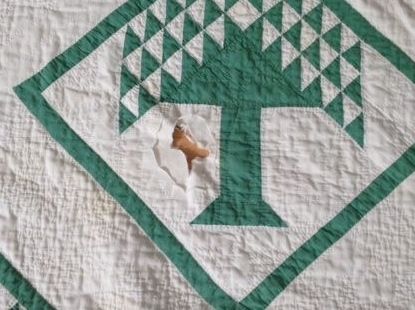
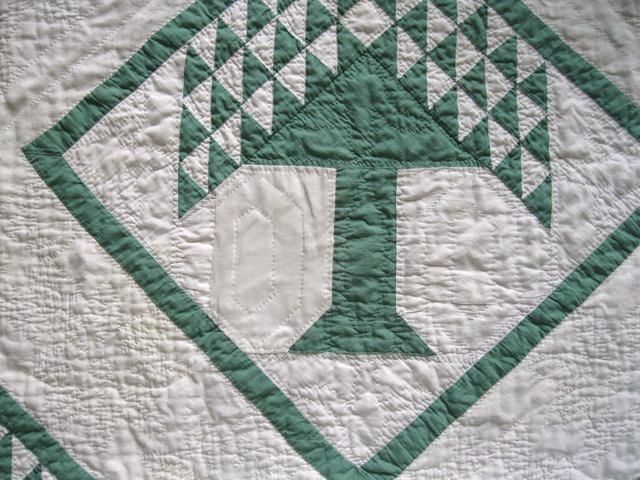
I offer an in-depth, 5 session workshop on quilt repair philosophy and techniques. You can attend the full workshop, or selected lectures on an alá carte basis. Registration for the full workshop includes lectures, how-to videos, supply samples, session recordings, group discussions, and more.
Questions about Your Quilt
I am always available for short questions via email. For a fuller assessment and/or instructions, you can sign up for one of the options below.
Repair Lessons, Virtual
I teach private lessons via Zoom, covering techniques, supplies, etc. These cost $75 for the first hour, and $50 per hour (or part of an hour, prorated) for additional time. You will need to send me a set of photos of the quilt and the damage prior to our lesson. How much time we'll spend depends on what your sewing skills are and what needs to be done.
(Photo instructions: one of the entire quilt, or as full as you can, front and back, and a few detail photos of the damage. Good, even lighting and focus is needed. I prefer larger rather than smaller photos. If you need to send them in more than one email, that is fine. Please only use email.) Register at AnnQuilts shop at Square.com.
Quilt Triage, Virtual
An assessment of age, condition, repair options, care options, etc. You will need to send me a set of photos of the quilt prior to our session.
Fee: $75. One hour.
(Photo instructions: one of the entire quilt, or as full as you can, front and back, and a few detail photos of the damage. Good, even lighting and focus is needed. I prefer larger rather than smaller photos. If you need to send them in more than one email, that is fine.)
(Note: This is not an appraisal and will not include a value estimation. For that you need to locate a certified appraiser, and I can give you some leads on that.) Register at my Square shop.
Repair Packet, Virtual
This choice gives you a more complete set of instructions than the single lessons. You'll send your quilt to me so I can assess it in detail. Then I will search in my stash for repair fabrics and send those to you when I return the quilt. (If there are things I don't have in my stash, you will go shopping for those.) I will prepare a demonstration and teaching video for you, and then we can have Q&A sessions via Zoom. You’d pay for my assessment and treatment plan, your personalized video, purchase of the repair fabrics from my stash, and instructional Zoom session(s). Email me to discuss this option. Minimum $250 plus round trip shipping of your quilt.

About Me
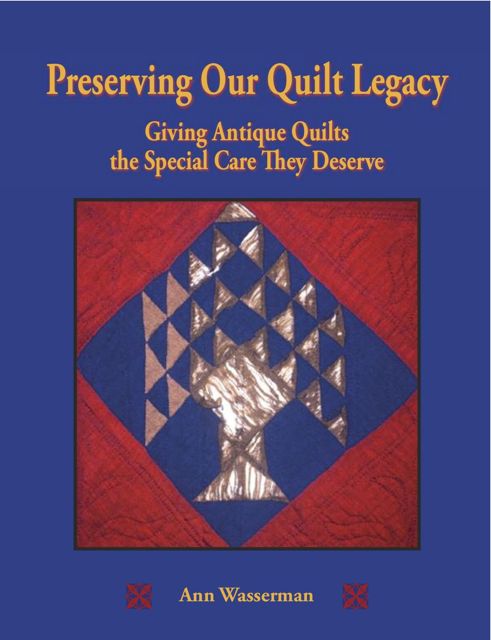
"Preserving Our Quilt Legacy"
A Unique Guide to Antique Quilt Care for Quilters and Quilt Collectors
by Ann Wasserman
Book Reviews
Examples of my repair work.
You can visit my blog for more photos and stories about the quilt repair process.
Further discussion of my quilt repair philosophy:
"Thoughts About Repairing Antique Quilts"
"Textile Stories"
"There is a Mystery in Every Antique Quilt:
This American quilter brings the story of these precious things to life again."
Feature article.
By Dorothee Crane. Quilt & Textilkunst Patchwork Professional, Germany. January 2018.

What is Quilt Repair?
Three Basic Rules of Quilt Care
*Do as little as possible.*
*Don't do anything that can't be undone.*
*Preventative maintenance is the best medicine.*
What is Quilt Repair?
In the professional conservation world, a distinction is drawn between restoration and conservation.
"Restoration" is also often referred to as "repair". A quilt is restored as closely as possible to its original state by replacing or fixing damaged or worn places. A quilt that is lovingly and thoughtfully repaired adds another chapter and another set of hands to its story. It's a good idea to keep a record of the repairs so that future owners can understand the quilt's history.
Professional conservators tend to dislike restoration for a number of reasons: Restoration lessens the historical integrity of the piece, i.e. a restored quilt is no longer exactly the antique it once was. In addition, restoration can lead to confusion, both for present viewers and for future researchers, as to what is original and what has been patched. Another important point is that restoration can be dangerous to the future life of the quilt. By definition, "repair" makes an object useful again. By putting a quilt back into the context of use that has already damaged it can only mean that the wear process will continue on the next set of weaker fabrics. It's important to understand that a repaired quilt is not as-good-as-new, but is still an antique with lots of weak fabrics.
Quilt Restoration
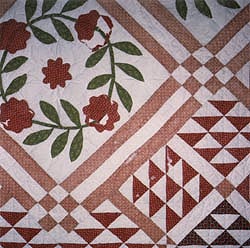 |
|
 |
Before
|
|
After
|
|
Worn patchwork pieces covered with new fabrics.
|
|
|
|
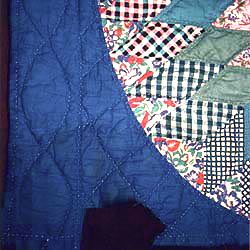 |
|
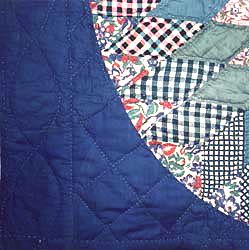 |
Before
|
|
After
|
|
Burn hole reconstructed with new fabrics and batting, and requilted.
|
|
|
|
 |
|
 |
Before
|
|
After
|
|
Torn corner reconstructed.
|
|
|
|
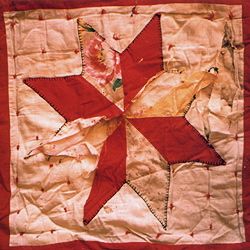 |
|
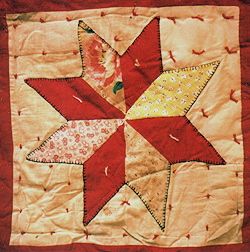 |
Before
|
|
After
|
|
Missing batting, fabrics, ties and embroidery replaced.
|
"Conservation", on the other hand stabilizes and maintains the current condition of the quilt. The only fabrics added to a quilt are those that give necessary structural support. Conservation processes protect and keep even the worn places, as past use is also part of the quilt's history. The use of sheer fabrics to cover and protect areas of worn fabric means that visual "neatness" takes second place to maintaining the historic information embodied in the quilt. Conservation processes take into consideration, not the short term use of a quilt by the current owner, but the preservation of the quilt as an historical document, and the maintenance of the quilt into the centuries ahead.
Quilt Conservation
 |
|
 |
|
Before
|
|
After
|
|
Worn silk with cotton underlay and sheer fabric covering.
|

After
Cotton covered with almost invisible tulle netting.

Pictures and a description of conservation on a spectacular and historically important mid-19th century quilt.
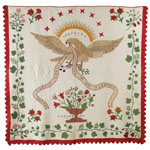

Deciding How to Treat Your Quilt
I've put the process of evaluating a quilt into an equation. Weigh the four points on the left together to come up with the direction you will take.
|
the quilt's overall condition +
|
|
|
|
the quilt's historical value +
|
|
|
|
what the quilt means to you +
|
|
|
|
how you plan to use the quilt
|
=
|
whether to do restoration or conservation |
|
|
+ how much time to spend on the quilt |
Overall Condition
• Quilt restoration or conservation is tedious business. In general, you can figure on averaging 3 patches per hour, including both locating the fabrics and doing the actual sewing. This varies from quilt to quilt according to size of patch, type of fabric, amount of quilting, and so on.
• Distinguish structural problems (e.g. holes or tears all the way through the quilt) from wear (e.g. disintegrated fabric). Mending structural problems is usually more urgent, and also takes longer per mend.
• Separate patchable places in three categories: eyesores, worn, wearing. "Eyesores" are patches totally missing, patches with torn fabric hanging loose, holes through all layers of the quilt, i.e. anything that I can see without my glasses. "Worn" are patches where the fabric is mostly all still there, but is torn and batting shows through. "Wearing" are patches where the fabric is obviously very weak and will not last much longer. The longer you look at a wearing quilt, the more wear you will see, guaranteed.
• If you are planning on hanging the quilt, all possible repairs need to be done along the top edge which will bear the weight of the quilt. Plan your time budget for the rest of the quilt from there.
• Consider how the quilt is apt to look when the job is done. The newly applied fabrics will never be exactly the same as the original fabrics. Restoration work done on a quilt with only two or three fabrics will be relatively obvious, while repairs to a scrap quilt tend to get lost in the busy-ness. The older an antique quilt, the less likely a newer fabric will blend in well.
Historical Value
• Is this a family heirloom?
• Is this an antique quilt with an exciting collection of vintage fabrics?
• Are there embroidered or inked inscriptions?
• Is this a museum-quality, or otherwise exceptional, quilt?
• All quilts hold some historical value, utility quilts included. Consider an otherwise unexceptional quilt that has survived 150 years - its value now resides in the fact that it avoided being "used up". Family quilts with known maker and provenance have even more historical value.
Consider your answers to these questions, and then consider how much you want to tamper with that historical record.
How You Value the Quilt
• Does the monetary value of the quilt have any part in your decision?
• Is the sentimental value really what is important to you?
• I am often asked whether repairing a quilt increases or decreases its value. At base, the value of the quilt is already lowered, with or without repair, just because it is no longer in fine condition.
Plans for Use
• If you want to hang the quilt, determine if it is strong enough.
• If you want to display the quilt, determine how worn a quilt can look and still appeal to you as a decorative piece in your home.
• If you want to continue using the quilt, remember that putting a repaired quilt back into the same context will generally lead to the need for more and more repairs down the road. You will either run it into the ground, or by continuing to repair it, you will, in essence, no longer have an antique quilt.
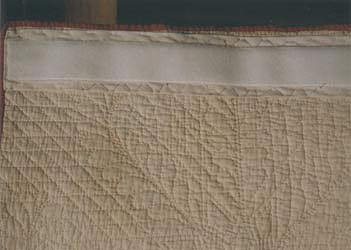
Velcro strip sewn to quilt back for display.

Washing Antique Quilts
Washing old quilts is very stressful for aged fibers, and is generally not recommended in the home. Conservation labs have complex equipment and procedures to ensure the best results possible. Even so, washing is always somewhat unpredictable due to the many unknowns of fabric dyes, stain identification, water quality, etc. Stains, which have been in the fabric for decades, and yellowing, which is a function of age rather than dirt, are not likely to disappear anyway. Spot stain removers, commercial dry cleaning, and agitation in a washing machine are all strictly contraindicated. All these are pretty much guaranteed to do more harm than good.
The only time I feel comfortable recommending washing is when the soil is so bad that it is obviously damaging the fabrics or making the quilt otherwise too unpleasant to use or store. Otherwise, the safest cleaning method is vacuuming, done with the protection of a piece of fiberglass screening (rough edges covered with twill tape) or cheesecloth (attached to vacuum nozzle). This avoids all contact with water and soaps, while removing dust and generally freshening the quilt.
If you are considering washing your quilt, I recommend following at least these basics for the safest results. Full, detailed instructions can be found in my book.
• Determine if the fabrics and batting are strong enough and able to withstand wet washing. Don't wash wool or silk.
• Handwash in the bathtub. Do not dry clean.
• Use a mild soap without whiteners, softeners, or perfumes. Orvus is often recommended by conservators. Do not use Woolite.
• Rinse at least 6 times. Then, spin in the washer (don’t agitate!) to squeeze out excess water.
• Lay flat to air dry on a plastic drop cloth. Flip regularly. Use a fan in the room to circulate the air.

Testimonials
Comments from past clients.
How to Contact Me for Quilt Repair
Contact me, Ann Wasserman, at annquilts@comcast.net.
I have 40 years of professional experience in quilt care and restoration. Services offered include: reconstruction of holes, patches (restoration fabrics or conservation sheers) over worn fabrics, replacing missing quilting or embroidery, preparation for display, vacuuming, and very occasional washing. I can work on patchwork, appliqué, crazy, and embroidered quilts.
The quilt repair process begins with you sending me some information:
•A few photos of your quilt: one of the entire quilt, or as full as you can, front and back, and a few detail photos of the damage. Good, even lighting and focus is needed. I prefer larger rather than smaller photos. If you need to send them in more than one email, that is fine. Please only use email.
• The approximate size of your quilt.
• As many answers as possible to the questions in the "Deciding How to Treat Your Quilt" section above about how you value the quilt and your plans for future use.
With this information, I can give you my opinion and a rough estimate via e-mail, but I can give a firm estimate only when I see the quilt "in person".
I currently have a waiting list. At this point, I can’t really give you a time estimate, I suspect it will be at least *11* months. But we can certainly discuss your quilt now via email, and I will put you on my list if you decide to proceed. I have recently started working with several assistants. Your quilt will likely go to one of them. Their work will be done under my guidance.
I can give you my opinion and a rough estimate via email, but I can give a firm estimate only when I see the quilt "in person".When your turn comes up, I'll ask you to send the quilt, along with the return shipping fee. We can then discuss the estimate and answer any questions you may have. If you decide not to go ahead with the repair, we'll send the quilt right back.
If you are considering washing your quilt before shipping, please contact me to discuss whether to do so and get the details of the process. Washing may not be the best thing to do. Please do not use soaps with strong fragrances. If the quilt has been washed previously with a perfumed product, I ask that you wash again with a fragrance-free soap. Also, if you have scented air fresheners in your house, please see if you can find an unscented place to let them air out before you send.
Home Book Art Quilts Quilt Repair Lectures and Workshops Quilt History Costumes Resumé Contact
Website created and maintained by Ann Wasserman.
Contents of this site may not be reproduced without permission.
All artwork, electronic images, and text are copyright ©2025 by Ann Wasserman.
![]()


![]()

![]()












